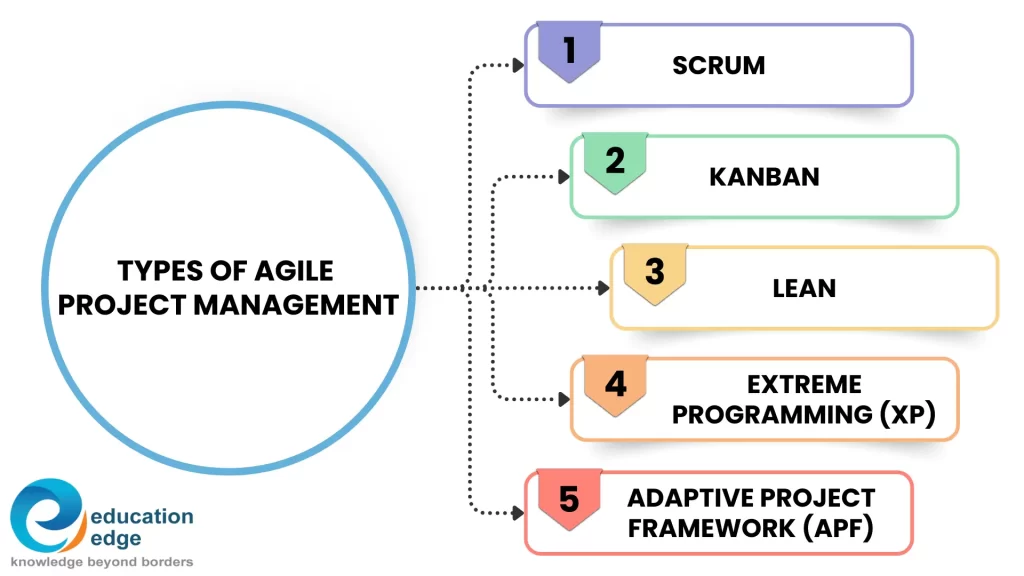
During the last few years, Agile project management has grown in popularity across the world. It is an iterative process that breaks the project into smaller sections and also helps the development team make necessary decisions throughout the project life cycle.
But have you ever thought about what is agile project management or is it worth the hype? Here you will get answers to all your questions. So, let’s get started!
What is Agile Project Management?
Agile project management is a process of dividing projects into small phases known as sprints. It is an iterative method that focuses on regular updates and contains client feedback to modify each product cycle and sprint.
This approach helps development teams improve development, collaboration, and the flexibility to adjust to market trends by giving quick feedback.
Types of Agile Project Management
Here are the following types of project management.

1. Scrum: It is perfect for those projects that require frequent changing by using short sprints.
2. Kanban: This agile project management is ideal for projects that require fixed output, and also predict the progress of the project.
3. Lean: It reduces waste and simplifies the project process. Its main aim is to maximize value and reduce waste.
4. Extreme Programming (XP): This agile model is used to enhance the responsiveness and quality of software for customer satisfaction.
5. Adaptive Project Framework (APF): It constantly adapts to evolving customer needs, so it is ideal for projects with unclear details.
5 Popular Agile Project Management Certifications
- Disciplined Agile Scrum Master (DASM) Certification
- PMI Agile Certified Practitioner (PMI-ACP) Certification
- Disciplined Agile Senior Scrum Master (DASSM) Certification
- Disciplined Agile Value Stream Consultant (DAVSC) Certification
- Disciplined Agile Coach (DAC) Certification
Principles of Agile Project Management
There are 12 principles of agile project management as follows:
- Customer satisfaction is achieved early and continuous software delivery.
- Accept change in requirements throughout the project management process.
- Deliver regularly in the form of software sprints and iterations.
- Working together by guaranteeing constant collaboration between business stakeholders, managers, and team members throughout the project.
- Motivate teams so that they are more likely to deliver their best work than unhappy ones.
- Face-to-face contacts help improve communication, especially when teams are co-located.
- Working software is the fundamental metric of progress for the customer.
- Control the pace to maintain regular growth.
- Good design and attention to detail boost agility and guarantee that teams are always improving the product and sustaining change.
- Simplicity in developing just enough to obtain the job done right now (without sacrificing quality).
- Self-organization empowers teams to make decisions, take ownership, communicate often, and produce high-quality goods.
- Reflect and change to become more successful and efficient as a team.
Why It’s Worth The Hype
Agile project management is popular among all project managers and provides project management skills to both teams as well as organizations.
Here are the reasons why it is worth the hype.
1. Superior Product Quality:
Testing of the project is essential throughout the Agile development cycle, which implies that there are regular reviews to ensure the quality of the project.
This allows the product owner to make adjustments as needed, while also informing the team of any difficulties.
- Defining and elaborating needs as soon as possible so that knowledge of product characteristics is as current as possible.
- Continuous integration and daily testing are incorporated into the development process, allowing the development team to resolve issues while they are still new.
- Making use of automated testing technologies.
- Sprint retrospectives enable the scrum team to continuously improve processes and work.
- Completing work by the concept of done: designed, tested, integrated, and documented.
2. Enhanced Project Control:
It enhances project control by facilitating things such as:
- Sprint meetings
- Transparency
- Uses of Jira Software
3. Increased Client Satisfaction:
The product owner is always involved, development progress is extremely visible, and adaptability is critical. This suggests client engagement and satisfaction.
- In each sprint review, clients are shown working functionalities.
- With each release, we are bringing items to market faster and more frequently. Clients have early access to the product throughout its life cycle.
- Maintaining consumer involvement and engagement across initiatives.
4. Reduced Risks:
- Agile project management techniques essentially reduce the possibility of total project failure.
- Having a working product from the very first sprint forward ensures that no agile project ever fails.
- Early revenue generation from self-funding initiatives enables organizations to fund a project with little out-of-pocket expense.
- Agile allows for flexibility while implementing new modifications. Because new increments are produced so frequently, they can be deployed for relatively little money.
5. Faster Return on Investment:
Agile development is iterative, which means that features are given gradually. As a result, benefits are realized quickly while the product is still in the development stage.
- Development begins earlier
- After a few iterations, you have a functional ready-to-market product
- Agile products are released quickly, and the flexibility to monitor customer feedback and adjust accordingly puts you ahead of the competition
- It emphasizes business value. The team understands what’s most important to the client’s business and can provide features in the most beneficial sequence by allowing the client to select the priority of features.
Frequently Asked Questions
1. What are the five Agile components?
ANS: The 5 Agile components are.
1. Process agility
2. Technological agility
3. Business agility
4. Cultural agility
5. Change management agility
2. What is the importance of Agile project management?
ANS: It is important for reducing waste, enhancing focus on customer satisfaction, boosting productivity and development process, etc.
3. What are the types of Agile project management?
ANS: The following are the Types of Agile Project Management.
1. Scrum
2. Kanban
3. Lean
4. Extreme Programming (XP)
5. Adaptive Project Framework (APF)
4. What are the 5 phases of agile project management?
ANS: The 5 phases of agile project management are.
1. Envision
2. Speculate
3. Explore
4. Adapt
5. Close
5. Why choose Agile over traditional project management?
ANS: Agile is known for its better adaptation, faster delivery, customer satisfaction, flexibility, continuous improvement, and effective risk management.
On the other hand, traditional project management is ideal for those projects with well-defined, constant requirements.







